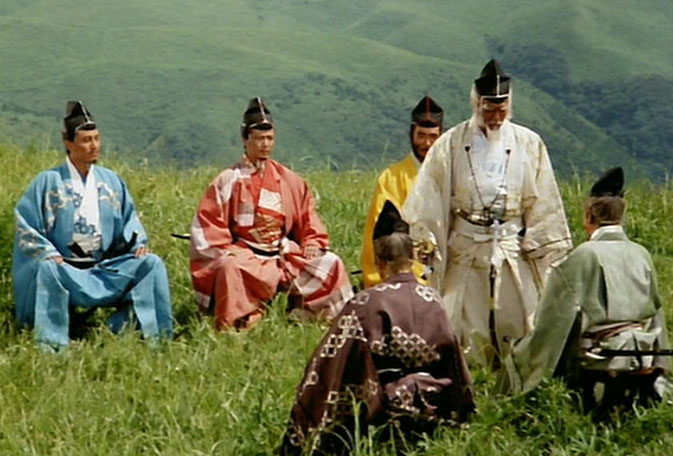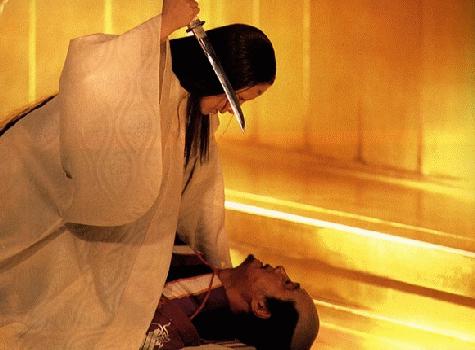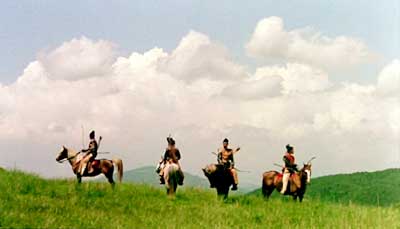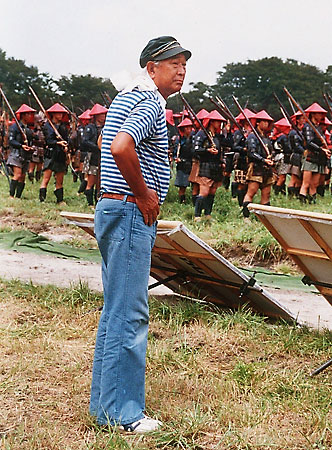There's no such thing as seeing a Kurosawa film only once. At least not for me. Second and third viewings reveal so much more. And so it is with Ran. The critics rave about Ran, Kurosawa's version of King Lear, praising it for "crystallizing the illusion of power and permanence," and for its statement about the human condition.
Okay. The movie does that, but I enjoyed it at a different, simpler level: just as a flawlessly produced epic and a costume drama of royal family intrigue. The battle scenes are brilliant. The villainous character of Lady Kaede steals the show. And the castles are magnificent, especially the Third Castle, an expensive set that Kurosawa burnt down for the filming.
Ran, like King Lear, is about a king, the Great Lord Hidetora Ichimonji, who tries to abdicate, splitting his kingdom amongst his three children, sons in this case: Taro, Jiro, and Saburo. (In Japanese, these names mean First Son, Second Son, and Third Son, another example of the language and cultural differences that make Ran best seen a few times on DVD, at least once listening to the critic's commentary.) The sons and their armies are color-coded: Taro is yellow; Jiro is red; and Saburo is blue. Even better, their soldiers' banners include one, two, or three stripes on the appropriate color background.

In the early outdoor formal scenes, the colors work very well to highlight the importance of the characters: Hidetora in the center is in gold-trimmed white. The three sons sit on one side, in bold, bright colors, befitting major players. Four other, less important characters flank them, dressed in muted paler tones: beige, lavender, light green, and plum.
In the manner of such stories, Hidetora's abdication leads to problems and civil war between the sons. Third son, Saburo, is the good, honest one, the Cordelia figure. But the character to watch is Lady Kaede, who starts as Taro's wife, but later marries Jiro. On second viewing, it's quite clear that she is the catalyst for all the action in the movie. One can see the movie as her story, and find it a compelling tale.
Of course, Hidetora, the King Lear figure, is nominally at the center of this movie. In the second half, there are many scenes of Hidetora and Kyoami (his Fool) wandering around desolate places, representing the futility of anything and everything in the human condition, or the indifference of the gods, or something. Honestly, on my second and third viewings of the DVD, I fast-forwarded through all those scenes. In the proper language of a film critic, "they do not advance the action of the plot." And, as I am very simplistic, I like this movie at its superficial level.
The first grand scene is the attack on Third Castle, with Hidetora inside. He leaves as the castle (a hugely expensive, exquisitely accurate set) is burned down. No special effects. The actor, Tatsuya Nakadai, actually performed and walked slowly through the burning castle. With no opportunity for a second take, as the castle was a smoking ruin after one take. Awesome. The accompanying battle scene is violent, bloody, dramatic, and in some perverse way beautiful. A more observant viewer than me would realize, on first viewing, that the red and yellow armies are collaborating in their attack. Also the figures of Taro and Jiro are quite obvious, in distinctive uniforms; Taro's assassination is not to be missed. Or, if you are like me, you can figure all these people out second or third time around.

The second memorable scene is the confrontation between Lady Kaede and Jiro, not long after Taro's murder. Wow. Don't miss the business with the squashed bug (butterfly?). All I can say is "she's no lady." This is a scene that you will definitely rewind on the DVD and watch again.
My third favorite scene involves Lady Kaede, Jiro, and Jiro's loyal general, Kurogane. No spoilers here; but it's a great scene. Kurogane is, in many ways, the counterpoint to Lady Kaede. In their own ways, both are totally loyal to their clans. (Again, if that seems an odd way to characterize the heinous villainy, treachery, and murder of Lady Kaede, watch it a second time.)
Kurosawa tried to minimize the connection to King Lear. He certainly made many modifications; indeed, my favorite character, Lady Kaede, has no direct parallel in Shakespeare's play. But, let's get real --- this is a Japanese version of King Lear. It's fair to note that the parable of the three arrows is a well-known Japanese story, told of a good Sixteenth Century Japanese warlord, M. Mori.

Kurosawa spent five years painting the story boards for Ran. And perfectionist that he was, the film accurately represented his vision. The opening scenes of the boar hunt on the mountain, the attack on the castle, some of the low-sun scenes, the second battle late in the film, the dramatic ending of the ruined castle in profile. Just as photography, or more accurately "cinematography," it's a magnificent piece of work.
"How can you watch a movie three times?" If you're watching Kurosawa, it's so you can absorb all the details. For example, late in the movie Lady Sue (pronounced "soo-ay") is murdered. Her lady-in-waiting, dressed in purplish attire, told Lady Sue that she would leave to go fetch a forgotten flute. Of course, Lady Sue winds up dead. Not long after, we briefly see the lady in purple in front of an approving Lady Kaede. A tiny detail, but one that informs us who fingered poor Lady Sue.

It's fun to see the actors in Ran and the roles they have had in other films. Tatsuya Nakadai, who played the poisonous young Unosuke twenty years earlier in Yojimbo, appears as the very old Lear-figure Ran. He also appeared in Kagemusha. The actor known as "Peter," presents a sexually ambiguous figure as Kyoami, the Fool; in fact the actor is known for cross-dressing and for his offbeat, hard-to-characterize roles. Jinpachi Nezu, who plays Jiro, is much better known in Japan as a rock star!
The picture above, is, of course, of Akira Kurosawa himself, on the set of Ran, with extras, gunnery troops of Jiro.
The article focuses on these few aspects of the film that I found interesting, and does not replace Wikipedia's excellent, encyclopedic article. Also, if you want a DVD, Ran (Masterworks Edition) is very good. Note that the Criterion Collection DVD of Ran has been withdrawn, over copyright issues. It's a shame, because the Masterworks edition is not up to Criterion's quality. Any real die-hard Kurosawa purist will want to pick up the Criterion DVD on eBay.